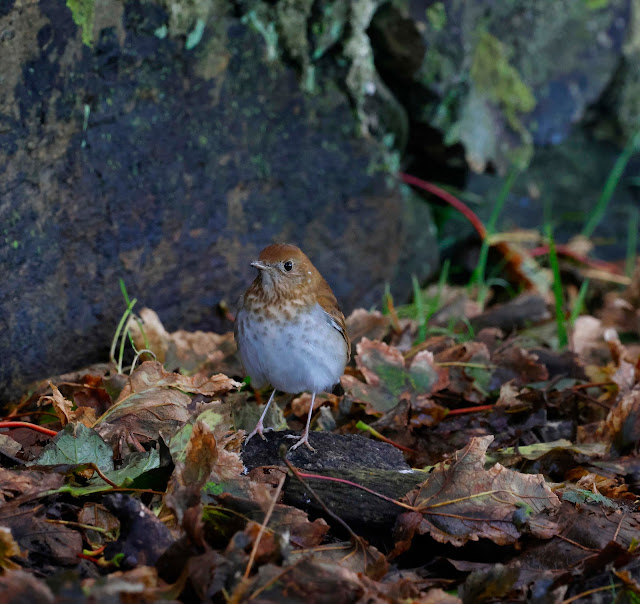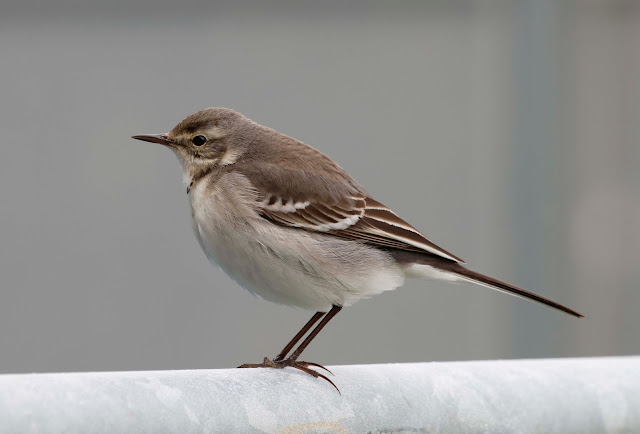30th September - A Veery at Lunna
As has become our custom, myself and Mark my birding colleague, headed for Shetland to spend two weeks seeing and photographing rare and unusual birds which are often wildly off course from their normal migratory routes and make Shetland a first landfall and sanctuary after a long and perilous journey, be it from the Far East or even from North America, depending on which way the winds have blown them.
We caught the overnight Northlink ferry from Aberdeen to Lerwick on the 29th of September, twelve hours of comparative comfort sleeping in a cabin, dependent on the state of the North Sea and whether one suffers from sea sickness or not. The outbound trip this time had a considerable boost to its normal excitement and anticipation as a Veery, a small thrush from North America had been discovered at a place called Lunna on Mainland in Shetland, just the day before. I have never seen a Veery, not ever, not in Britain nor in its native North America, so my nerves were certainly on red alert. A bird that is both a mega and a lifer is the ultimate when it comes to twitching.
Veerys are normally found breeding across southern Canada and northern USA where they inhabit humid deciduous forests and migrate to spend the winter in central and southern Brazil.They cross the Gulf of Mexico on their autumn migration and this is where they can become susceptible to being blown off course by hurricanes and storms and this may well be how the bird at Lunna came to be on Shetland.
Veerys are very rare in Britain and one can rightfully call them a mega in twitcher parlance.There have been only 11 records of a Veery in Britain before this latest arrival on Shetland. The first was at Porthgwarra in Cornwall on the 6th of October 1970 and the last at North Ronaldsay in Orkney from the 30th May to the 9th of June 2015.
There have been three previous records from Shetland, one on Unst on 20th September 2005, another on Foula from the 1st-5th of October 2009 and the last was on Whalsay from the 2nd-5th of October 2009.
I lay on my bunk in our cabin mulling over whether the Veery would be there tomorrow or would it have gone.My anxiety precluded any easy sleep or general relaxation but eventually I slept and awoke next morning to a rather typical Shetland morning of light rain and lowering grey cloud.
Our plan, once off the ferry was to drive straight to Lunna which is only half an hour's drive north of Lerwick and hopefully see the thrush. Finally I got a signal on my phone as the ferry approached Lerwick but there was no news about the Veery. It seemed to take an age to be called to our fully laden car below decks but eventually we received permission to go to our car and drive off the ferry.
Just after leaving the ship news came through that the Veery was still at Lunna. Excitement levels rose rapidly but were tempered with a healthy dose of relief as the worry about the Veery having departed overnight was dispelled.
I took the familiar road north out of Lerwick in what would pass for the rush hour but in most places would be considered of no consequence. The rolling contours of brown barren moorland stretched in vast emptiness on both sides of the road that carved a grey ribbon of long straight stretches and sweeping curves across the land.
October in Shetland precedes the bleakness that comes with the long winter nights and the light was only slowly beginning to brighten as we drove north. It was still dull at 8.30am as we turned off the main south to north highway and took to a narrower serpentine road signposted for Vidlin.We rarely met another car but if we did it was accommodated by dexterous judgement of who would pull over into a passing place to allow the other to pass.This manouevre always acknowledged by both drivers with a casually raised hand. A common courtesy amongst the people living in this isolated part of Britain and reciprocated by visitors.
At Vidlin we turned onto an even narrower road, signposted to Lunna, that undulated away into the hinterland. Great gashes of sea called voes cut into the land as sheep stood in insouciant ease at the roadside.Up,down and round tight bends and blind summits we ventured, never meeting another vehicle until finally we arrived at Lunna and found the small churchyard car park already full, with a number of other birder's vehicles parked on the nearby verge.
Getting ourselves together, we walked the fifty or so metres to cross the road to a gate that opened into a wet and muddy field as light rain began to fall, the shower arriving as a grey swirl on the wind, obliterating the surrounding moorland and voes, forming an annoying inconvenience and bringing additional misery to my current tiredness,
We walked a short distance down the sloping field to an obvious line of low syacamores running alongside a drystone wall and protected by a wire fence.
I got my scope on it and my first impression was of a small thrush, larger than a Robin but smaller than a Song Thrush. Like the latter it had an upper breast of buff, covered in faint diffused brown spots but its white underparts were clear of markings and the entire upperparts were strikingly rufous.Its legs and feet noticeably pale pink.
It was not there for long and disappeared behind some nettles and was gone from sight for quite a time. Everyone assumed it remained behind the nettles but it was discovered further down the line of sycamores and we all made haste down the field to get closer. It seemed untroubled by its admiring audience and hopped along at the base of the wall turning over the dead, fallen sycamore leaves looking to expose unsuspecting prey.
Slowly the crowd dwindled and gradually those who were left moved closer towards the fence. I spoke to a birder who said that yesterday the bird was found to be ridiculously confiding and that they had stood right by the fence and looked at the bird feeding unconcernedly under the sycamores.
Soon everyone was standing by the fence and sure enough the bird hopped from one end of the sycamores to the other feeding and showing no alarm whatsoever.
I wandered to the upper end of the sycamores where there was a nettle patch, behind which I could conceal myself but still with a view down and along the ground below the trees.I waited and as anticipated the thrush came to my end and was very close indeed - no more than a couple of metres.
It was in front of me for five minutes, a magical time with this very rare bird granting me views I had thought impossible but had secretly hoped for last night on the ferry.
There was no sign of the Veery on the 4th of October. Gone but not forgotten!
30th September - Orcas and others
Once we had finished with the Veery we readied ourselves for the drive back to our accommodation at Wadbister just north of Lerwick, where we had still to unload the car of all our baggage and where we would be staying for our first week. Before leaving Lunna I checked the several Shetland WhatsApp groups that exist to update one on bird and cetacean sightings. There was not much bird news but thrillingly a pod of Orcas (Killer Whales) had been reported moving south at Levenwick which is to the south of Lerwick.
Both myself and Mark needed no second bidding.We had to go for them, no question.When news of Orcas breaks you go, immediately, without delay.We were well north of Levenwick but once on the main A970 we made good time as more reports came in of the Orcas making their leisurely progress south.
A decision had to be made and in order to intercept them we decided to try and get well ahead of them by making for Sumburgh Head, the southernmost point of Shetland to await their hoped for arrival there.It was a calculated gamble but they were moving south, Levenwick is not that far from Sumburgh Head and if they carried on their current course they would pass Sumburgh Head where we could look down on them.
Arriving at Sumburgh we drove up to the headland and joined half a dozen others who had the same plan as us. For half an hour there was no sign of the Orcas but then a sharp eyed observer saw the huge fin of a bull Orca some miles north of us but obviously coming our way. Our plan had worked.Slowly the pod checked each inlet in the cliffs and at first were discernible only when their dorsal fins materialised as tiny triangles of black above the vast sea but inexorably they came closer until they were clearly visible to one and all.By now the crowd had expanded to around sixty and shouts of excitement came and went as the Orcas surfaced and the mighty dorsal fins of the two bull Orcas stood proud and menacing above the sea.
Eventually they approached and then passed us but sadly this time gave no close or extended views as they remained almost continually submerged as they passed and only came back into view once well beyond the head.
Well follow that!
Obviously we couldn't but we still had to go shopping for provisions for our stay. Tesco's, on the outskirts of Lerwick was our store of choice but before enduring the inevitable drudgery of trailing around a busy superstore we had one more birding card up our sleeve.
Near to the store lay some fields in which apparently were to be found, separately, a long staying Bluethroat and a juvenile Citrine Wagtail. We looked for the Bluethroat first, which was inhabiting almost exclusively an isolated dock and nettle patch in the middle of a field complete with small piles of dung, courtesy of a horse that shared the field. At first there was no sign of the bird but eventually it appeared on its favoured pile of dung at the right hand end of the nettle patch. Hardly the brightest individual of its kind I have seen but nevertheless a good bird to see.It hopped about very much like a Robin before disappearing back into the cover of the nettle and dock patch which was the only cover available in a field of otherwise short cropped grass.
We stood looking over a wall that separated the field from the lane and slowly both wagtails came closer and closer until they were both at point blank range. Naturally I paid almost exclusive attention to the Citrine Wagtail which afforded me probably the best views I have ever had of one.
Somewhat similar to a Pied Wagtail in being grey and white, all the distinguishing characteristics that separate it from its commoner cousin were there for all to see.The feature that struck me most was the delicate necklace of grey flecks across its upper breast.
It strutted around on the grass in typical cheery fashion before flying up onto a metal bar and then flew away never to be seen again


.jpg)


.jpg)
.jpg)











.jpg)











Another great write up Ewan. Managed to catch up with it myself on the Saturday. And what a bird it was.
ReplyDelete